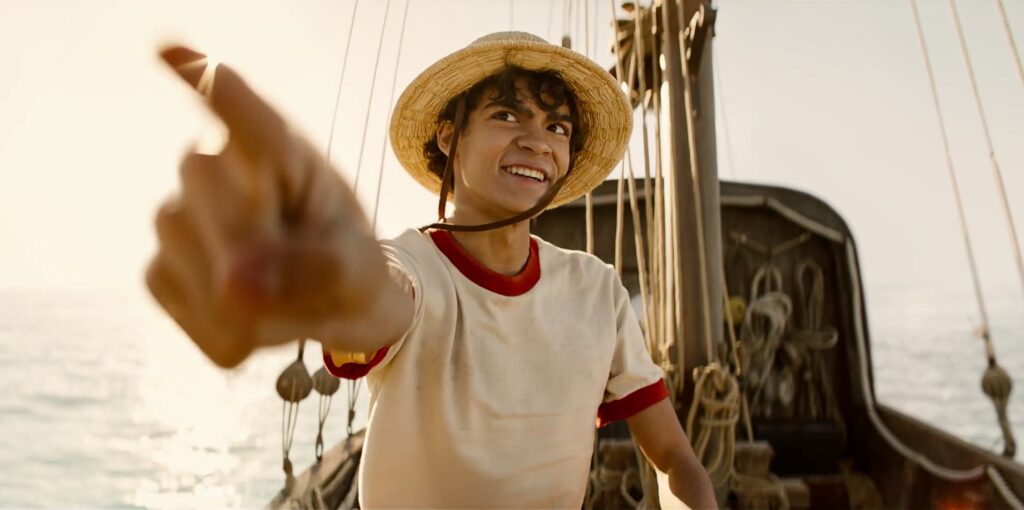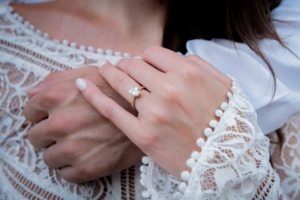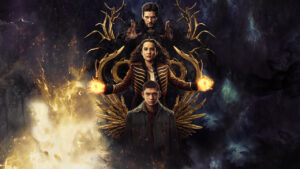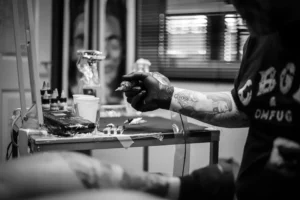This piece was written during the 2023 WGA and SAG-AFTRA strikes. Without the labour of the writers and actors currently on strike, the series being covered here wouldn’t exist.
Before I watched Netflix’s One Piece, I had seen glimpses of Monkey D. Luffy and the Straw Hats. I was vaguely aware of these characters, but I didn’t realise that the series had such a significant cultural impact globally. My introduction to Japanese anime started a few years ago. My friend recommended Hiromu Arakawa’s Fullmetal Alchemist: Brotherhood, and I was hooked from the first episode. Since then, I’ve watched Haikyu!! and Cowboy Bebop (both the anime and the live-action series). It is almost impossible to escape the ‘anime series to live-action curse,’ where Japanese characters are Americanised. But this pipeline has been proven to be a success with Netflix’s One Piece, which might’ve beaten the live-action curse.
Two years ago, the streaming giant released Cowboy Bebop, and I was excited to dive into this series. Shinichirō Watanabe’s Cowboy Bebop is about a trio of bounty hunters: Spike, Jet and Faye, who travel around the galaxy hunting down dangerous bounties for a living. The original anime series is incredible. I was excited to see some of the iconic scenes replicated in a live-action format. While the series had good chemistry, Netflix’s Cowboy Bebop lacked the style to emulate the beauty of the anime series. It had its charms, but the general set design and dialogue lacked the charisma that the characters had in the series. It doesn’t have the same magic as the original one. I don’t necessarily agree with adapting every anime series into a live-action format, but it can work if a series is handled with care, especially by people who understand the characters, backstory and lore.
In Hollywood’s history, and what I remember from my earliest encounter with a live-action anime movie, Dragon Ball Evolution was not well received. I don’t know the reception surrounding the movie now, but this movie is always taken as an example — as a reminder — that Hollywood should stay far, far away from anime series. But that didn’t last for long. Rupert Sanders’s Ghost in the Shell, starring Scarlet Johanson, received much backlash due to the whitewashing controversy, and Netflix’s Death Note was critically panned; there was no way of escaping this abysmal hell.

The biggest issue with adapting anime has always been about casting. Anime series have predominantly Japanese characters. But Hollywood movies, looking back at the previous castings, have always filled these roles with white actors. This controversy has been discussed for a long time. The truth will always be that Johansson’s role could have been easily given to a worthy Japanese actor instead of focusing on star power.
I’ve looked down on and judged all the previous iterations of ‘anime series to live-action adaptations’ for so long. So when Netflix’s One Piece was announced, I refused to partake in any of the promotions. I didn’t watch the trailer or any of the promotional junkets. My expectations of live-action adaptations have been so low in the past, especially with Cowboy Bebop, that I knew, deep in my heart, I would be disappointed once again, and boy, was I wrong.
Netflix’s One Piece begins at the execution of Pirate King Gol D. Roger (Michael Dorman), where he announces that the legendary One Piece treasure is hidden somewhere on the Grand Line. Fast forward to two decades later, not a single pirate has found the mythical treasure. One teenager, Monkey D. Luffy (Iñaki Godoy) dreams of becoming the King of the Pirates with his ship and crewmates. With a determined enthusiasm, Luffy begins to assemble a pirate crew and secure a ship. He finds deadly bounty hunter Roronoa Zoro (Mackenyu), who dreams of becoming the world’s greatest swordsman wielding three swords; thief, expert navigator and cartographer Nami (Emily Rudd) dreams of mapping the entire globe; sharpshooter Usopp (Jacob Romero) wants to become a brave warrior of the seas and fashionable and smooth-talker chef, Sanji (Taz Skylar), who dreams of discovering All Blue, where fish from all the seas would be found. The Straw Hat Pirates — named after Luffy’s headgear — embark on many adventures and defeat villains across the seas, from mad clown Buggy (Jeff Ward), fishman Arlong (McKinley Belcher III), Captain Alvida (Ilia Isorelýs Paulino) to Vice-Admiral Garp (Vincent Regan). Luffy is a fearlessly optimistic pirate, and despite their bad reputation, he is determined to do good and help people achieve their dreams.

From the first episode (the series has eight episodes in total), One Piece introduces an adventurous story with likeable characters. If a series spends too much time with expositions and relies on new audiences to watch it having prior knowledge of the source material, this doesn’t bring in new fans. The showrunners Matt Owens and Steven Maeda make sure to guide old fans of the manga and anime series, as well as the new fans, with ambitious storytelling. None of the episodes includes fillers. The series focuses on the important details: The Grand Line, All Blue, Luffy’s Gum Gum fruit, The Straw Hat Pirates, Going Merry, and Arlong’s capture of Nami’s home island, Coco Island.
One of the reasons why One Piece beats the live-action curse, and Cowboy Bebop failed and cancelled after just one season, is that the nautically adventurous series paid homage to these characters. When showrunners understand the lore and bring the gimmicks of the weird characters to the screen, this is the result of it. A good, collaborative result that will introduce new fans to Luffy and the many weird characters on the show. I’m looking at you, Buggy fans.
One of the remarkable aspects of One Piece is the casting of these iconic characters. Godoy, Mackenyu, Ruddy, Skylar and Romero embody these roles with exuberant performances. While previous live adaptations have been miscast, this series gets it right down to the uncanny resemblance. Godoy cranks up the scene with his energy and charm, cheering his crewmates with a glorious ‘anime-like’ smile, handles his peculiar powers, and throws up his fist in that trademark pose. Mackenyu, Rudd, Skyler and Romero were also perfectly cast into their roles. They are exceptionally talented actors who bring their own set of skills to the show.

I don’t know what else to tell you. I loved this series, and for someone who has been the number one hater of the anime-series-to-live-action pipeline, One Piece passes the test. From the first episode, the story was engaging and adventurous. The characters were witty and delivered hilarious quips in their dialogue, even though some of the lines were kind of cheesy. But that’s anime! There are layers of weird and funny plots and characters, which I feel One Piece nails from the beginning. While the WGA and SAG-AFTRA strikes are currently ongoing and numerous series are being affected due to the struck companies not paying fair wages to the actors and writers, I would hope that Netflix doesn’t cancel this series on a whim. The streaming giant and the remaining struck company’s refusal to acknowledge the importance of a writer’s room leads to shows that lack the narrative drive and punch for good storytelling. This isn’t the case for One Piece, but there are several shows on the platform that suffer from these decisions.
Regardless, One Piece is a merrily entertaining, seafaring, pirate-hunting adventurous series that stays true to its source material. A thrilling and captivating adaptation that shows the results of the showrunner’s efforts to seamlessly translate the material with care, even if it means going through multiple revisions. Perhaps the streaming giant is learning from its past mistakes. The lesson to learn is that if the creators, writers and actors treat the source material with care and have creative freedom to work on adapting content like this, One Piece is the result.
Strike Funds: https://docs.google.com/document/d/1weorhmG1H7cszY3rGHCpNYsgleegkuOSH7rD47JzSAQ/edit
Solidarity with striking film and television workers: https://freelancesolidarity.org/wga-sag-strike-solidarity/
Check out:







Be First to Comment